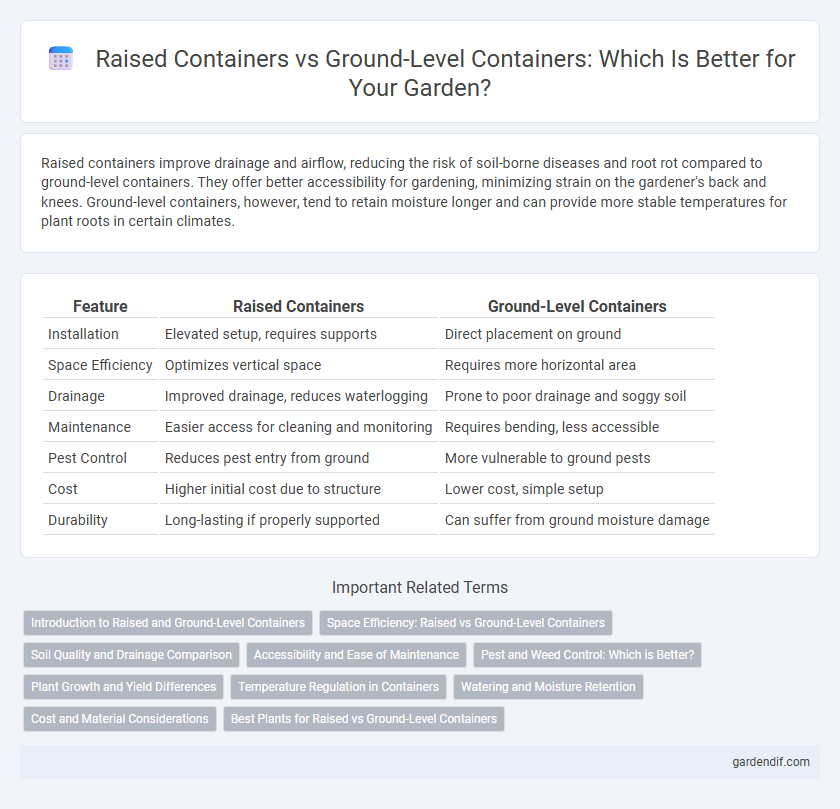
Raised containers vs ground-level containers Illustration
Raised containers improve drainage and airflow, reducing the risk of soil-borne diseases and root rot compared to ground-level containers. They offer better accessibility for gardening, minimizing strain on the gardener's back and knees. Ground-level containers, however, tend to retain moisture longer and can provide more stable temperatures for plant roots in certain climates.
Table of Comparison
| Feature | Raised Containers | Ground-Level Containers |
|---|---|---|
| Installation | Elevated setup, requires supports | Direct placement on ground |
| Space Efficiency | Optimizes vertical space | Requires more horizontal area |
| Drainage | Improved drainage, reduces waterlogging | Prone to poor drainage and soggy soil |
| Maintenance | Easier access for cleaning and monitoring | Requires bending, less accessible |
| Pest Control | Reduces pest entry from ground | More vulnerable to ground pests |
| Cost | Higher initial cost due to structure | Lower cost, simple setup |
| Durability | Long-lasting if properly supported | Can suffer from ground moisture damage |
Introduction to Raised and Ground-Level Containers
Raised containers offer improved drainage and easier access for planting, making them ideal for areas with poor soil or limited space. Ground-level containers provide natural soil interaction and better temperature regulation, benefiting deep-rooted plants and larger gardens. Both container types enhance gardening flexibility by accommodating different environmental conditions and plant needs.
Space Efficiency: Raised vs Ground-Level Containers
Raised containers maximize vertical space utilization, allowing for better airflow and easier access to contents, which is ideal for limited floor areas. Ground-level containers provide stability and support for heavier items but consume more horizontal space, potentially reducing overall storage capacity. Choosing raised containers enhances space efficiency in compact environments by enabling multi-tier organization and streamlined inventory management.
Soil Quality and Drainage Comparison
Raised containers enhance soil quality by allowing the use of customized, nutrient-rich soil mixes, preventing soil compaction and improving root aeration compared to ground-level containers. Elevated design significantly improves drainage, reducing waterlogging risks and promoting healthier plant growth by preventing stagnant moisture conditions common in ground-level setups. Ground-level containers often suffer from poor drainage and soil contamination risks due to direct contact with native soil, limiting control over soil composition and moisture retention.
Accessibility and Ease of Maintenance
Raised containers offer superior accessibility by minimizing the need for bending and lifting, reducing physical strain during planting and harvesting. Ground-level containers facilitate easier maintenance tasks such as watering and soil amendments due to their proximity to the ground. Raised containers often provide better drainage and pest control, contributing to overall plant health and reducing upkeep efforts.
Pest and Weed Control: Which is Better?
Raised containers offer superior pest and weed control compared to ground-level containers due to their elevation, which reduces direct access for common pests like slugs and snails. The contained soil environment in raised containers limits weed seed infiltration, minimizing weed growth without frequent herbicide use. Ground-level containers are more prone to weed invasion and pest damage, often requiring increased maintenance and preventive measures.
Plant Growth and Yield Differences
Raised containers improve soil aeration and drainage, promoting stronger root development and higher plant yields compared to ground-level containers. Enhanced control over soil temperature and moisture in raised containers supports accelerated plant growth and reduces disease incidence. Ground-level containers often face soil compaction and poorer drainage, leading to slower growth rates and decreased crop productivity.
Temperature Regulation in Containers
Raised containers offer enhanced temperature regulation by providing better air circulation beneath the container, reducing heat buildup and preventing soil from overheating. Ground-level containers often experience greater temperature fluctuations due to direct contact with the earth, which can either absorb heat or cold, affecting root health. Effective temperature management in raised containers helps maintain optimal growing conditions and improves plant resilience.
Watering and Moisture Retention
Raised containers offer superior water drainage while maintaining consistent moisture levels, preventing root rot and promoting healthy plant growth. Ground-level containers tend to retain excess water, increasing the risk of soil compaction and poor aeration, which can hinder root development. Efficient watering in raised containers reduces water waste and supports optimal moisture retention for diverse plant species.
Cost and Material Considerations
Raised containers typically cost more due to the additional materials required for elevated support structures, such as metal or treated wood frames, which enhance durability and drainage. Ground-level containers are often less expensive to produce and maintain, primarily utilizing plastic or lightweight materials with minimal support, but may face higher risks of moisture retention and pest infestation. Choosing between raised and ground-level containers involves balancing initial investment against long-term maintenance costs and material longevity.
Best Plants for Raised vs Ground-Level Containers
Raised containers provide improved drainage and soil warmth, making them ideal for root vegetables like carrots, beets, and potatoes, as well as leafy greens such as lettuce and spinach. Ground-level containers maintain consistent moisture levels, which benefit plants like tomatoes, peppers, and herbs including basil and oregano. Choosing plants based on container height and soil conditions enhances growth and productivity.
Raised containers vs ground-level containers Infographic

 gardendif.com
gardendif.com